Practical Sailor has long lamented the lack of imagination in the design of personal flotation devices (PFDs), and part of the reason for this creative stagnation is the red tape involved in complying with U.S. Coast Guard standards for PFDs. If a new company wants to introduce a Coast Guard-approved PFD, it usually reverts to an existing design or contracts a company that specializes in navigating the approval process. Everything from fabric selection to the location and type of buoyancy material is under scrutiny; the approval process can last more than two years.
Except in special circumstances in some states, there is no requirement that an adult sailor wear any PFD. Generally, a cruising sailor or casual racer can wear anything (or nothing), so long as he has one U.S. Coast Guard-approved PFD on board for each crew member. The PFD situation is more complicated for racers, who are sometimes required to wear a PFD during a race, or at the start and finish. Most prominent U.S. races that require wearing a PFD stipulate that it be Coast Guard-approved.
Not everyone, however, is accepting the status quo. According to one coach we spoke with, dinghy sailors in local or regional U.S. races often wear lightweight 50-newton buoyancy aids even though they technically aren’t permitted by the race rules. Enforcement is light unless someone protests. And protests are pretty rare because the racers like to wear them, he said.
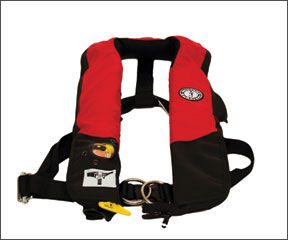
Compliant with International Standard Organization (ISO) standard 12402, the 50-newton devices are allowed in races everywhere except the U.S. Although they can be less buoyant than Type III U.S. Coast Guard-approved jackets, these swim aids (as they are generally referred to here) offer a practical alternative for dinghy and sport-boat sailors in near-shore waters.
Under the Coast Guard standards, a Type III PFD is merely a flotation aid. Unlike a Type I or Type II PFD, they are not designed to help right a face-down wearer or to keep an unconscious persons head above water. They merely help the wearer hold a stable face up position in calm water.
What We Tested
Rather than take a comprehensive look at all the many models being developed specifically for racing sailors, we wanted to take a broad look at the various types of PFDs in this category. We rounded up seven flotation aids from four manufacturers: Float-Tech, a U.S.-based company known for its innovative inflatable float coats; Gill, a United Kingdom-based company that is a worldwide leader in sailing apparel; Spinlock, a sailing equipment maker that specializes in racing gear; and Stohlquist, a Washington-based company that caters to white-water paddlers. Only the Stohlquist PFDs met U.S. Coast Guard standards.
How We Tested
Two PS editors rated and reviewed the flotation aids with the help of four adults, two men and two women, who ranged in size from 6 feet, 2 inches tall and 180 pounds, to 5 feet, 1 inch tall and 110 pounds. At least two adults tried each test PFD. Testers evaluated life jackets for buoyancy, ease of donning and removal on land, ease of escape in the water, comfort and fit in and out of the water, and freedom of movement. We tested them in activities ranging from dinghy sailing to kayaking. In-water testing took place in a swimming pool and in the ocean. Each vest was weighed and closely inspected for key construction and design features, such as reflective tape and personal locator beacon (PLB) attachment points. Vest ratings, buoyancy, and price helped determine top picks.
Float-Tech
The minimalist Float-Tech Sea Tee is a stretchy, nylon rash-guard with an inflatable chamber sewn inside the chest and shoulders. The shirt is manual inflation only: Pull the tab, and the C02 cylinder does the rest. Manual inflation makes sense given its intended use-high-intensity sports in which the wearer is bound to get wet. It was the only product we tested that allowed testers to effortlessly dive underwater without disabling an auto- inflator. It proved ideal for snorkeling.
Weighing only 14.5 ounces, the Sea Tee is very comfortable out of the water. In the water, however, the distribution of the flotation makes for an awkward fit. Because of the stretchy nature of the material, the shirt tends to slide up when it is inflated.
Nevertheless, the Sea Tee provided enough buoyancy to keep the wearers head well above the water while floating on his back. Although testers were able to swim with the shirt on, it tended to bunch up around the neck.
Bottom line: If light weight, comfort, and an ability to dive beneath the water are priorities, the Sea Tee fits the bill. It provides an added measure of security when you are too tired to swim or are injured, and it is well suited for warm-weather pursuits when youd rather not wear a life jacket.
Gill
The Gill Compressor (1 pound, 7 ounces) and the Gill Skiff Racer (1 pound, 10 ounces) were the lightest and least restrictive, non-inflating PFDs in our test. These IS0-approved, 50-newton buoyancy aids are flat-out racing vests, designed to maximize freedom of movement. Less cumbersome than a conventional PFD, they permit an active racing sailor to move nimbly around his boat while still complying with PFD regulations for his class in international events.
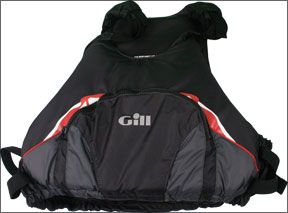

Black is the only available color-a sure tip-off that safety isn’t their chief aim. (The Pro Racer, a close cousin of the Skiff Racer, also comes in red-a more practical color choice, in our view.) Several other makers offer similar designs, including Zhik, Slam, Neil Pryde, and Spinlock. Although the rest of the world is allowed to use these during international events, neither Gill PFD meets U.S. Coast Guard standards, so they are technically rule-breakers in some U.S. races that require PFDs.
The Compressor was by far the most comfortable non-inflatable PFD tested. Made of body-hugging neoprene with multiple closed-cell foam panels to add buoyancy, the Compressor slips on like a tank-top shirt and is only slightly bulkier than a wetsuit vest. A three-quarter-length zipper makes it easy to slip over clothing, and a belt cinches the waist. In a few quick seconds, not only do you have an extra 9 pounds of buoyancy, you look like you just stepped into a nearby phone booth and emerged as Superman. With the sole buckle neatly tucked into a neoprene sleeve, the Compressor is virtually snag free.
During in-the-water testing, the Compressor was an excellent swimming aid. Although it did not keep the wearers head afloat as well as U.S. Coast Guard-approved PFDs, it is a good choice for closely monitored, near-shore races, where an ability to quickly right a capsized vessel takes precedence over maximum buoyancy.
With just front and back flotation panels, the nylon Skiff Racer resembles an old-school ski-vest cut off at the waist. Like the Compressor, the Skiff Racer emphasizes mobility, but it is more adjustable than the Compressor, which must be carefully sized to fit the body. Adjustment buckles on each shoulder and a combination clip/adjustment buckle at the waist ensure snug fit on most frames. All three adjustment buckles slip into dedicated sleeves, so they wont snag on lines or rigging.
Flotation in this vest was nearly as good as some Type III devices weve tested, and the shoulder straps allowed the wearer to vertically position the flotation panels, where they are more effective, or least obtrusive. Elastic bands gather extra material under the arm and along the waist. A front zipper pocket provides a place for sunscreen, a small VHF radio, or PLB. A loop inside the pocket offers a place to attach safety lanyards. The vests reflective piping will light up under a searchlight, but-oddly enough-its located on the back where it wont be visible if the wearer is floating face up. Presumably, he or she will be swimming somewhere, thus exposing the back to a searchlight. While testers were impressed with the buoyancy that the Skiff Racer provided in the water, it should still be regarded as a swimming aid-limited to daytime use.

Bottom line: If mobility is what youre after, the Compressor, our Best Choice for racing PFDs, does the trick. The Skiff Racer (and its near twin, the Pro Racer) achieves the same degree of mobility with a little extra bulk and decidedly less sex appeal. It is our Budget Buy for racing sailors who don’t have to worry about U.S. Coast Guard requirements.
Spinlock
Like the previous inflatable PFDs that weve tested from U.K.-based Spinlock, the new Deckvest Pro-Sensor and Deckvest Lite are not U.S. Coast Guard approved, and currently, the company has no plan to seek certification. In terms of performance, the Deckvests are as good as, or better than, USCG-approved inflatable PFDs (Type V) that we have tested-but theyre also more expensive. The Deckvests remain especially popular among serious racing sailors, even in the U.S.
The Deckvest 170N Pro-Sensor inflatable PFD-harness uses a United Moulders inflation system that makes it easy to confirm that the C02 inflation cartridge is fully charged and properly installed. The Pro-Sensor activates when water passes upward through the bottom of the sensor. This prevents accidental inflation from heavy spray or rain, a problem in some older auto-inflation systems.
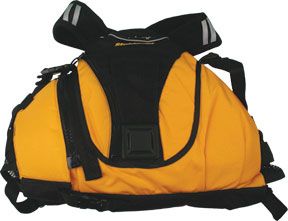
The Deckvest Pro-Sensor is also available with the Hammar MA1 inflator, the same inflator found in the Mustang 3184, Practical Sailors top-rated inflatable PFD-harness in December 2006. The MA1 inflator is even more resistant to accidental inflation, requiring full immersion (about 4 inches) to activate. The MA1 adds about $30 to the Deckvest price, and a spare re-arming kit costs $85, versus $35 for the United Moulders kit. The United Moulders Pro-Sensor resisted accidental inflation in direct spray and is much easier to re-arm than the Hammar. The Pro-Sensor can also be switched from auto to manual inflation, which is not possible with the Hammar MA1.
The new Deckvest Pro-Sensor 170N improves upon the Deckvest 150N we tested in 2007. It adds buoyancy and incorporates several new features, including a new shoulder system, a high-intensity strobe mounted on a nine-inch pylon, a built-in cutting tool on a lanyard, a mesh pocket for a personal locator beacon, a lower-profile collar, and a new back adjustment system. Like its predecessor, the Pro-Sensor uses a high-strength, stiffened webbing loop for tether attachment, instead of a heavy D-ring. This reduces weight and eliminates the annoying-although sometimes reassuring-clanking as you move around deck.
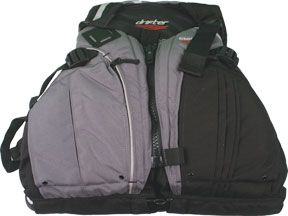
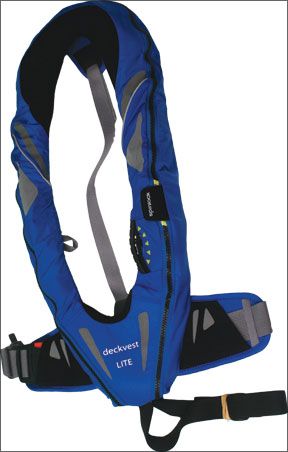
Other key features include a spray hood, super-sized reflective patches, and crotch straps. As weve reported in the past, crotch straps-now required under International Sailing Federation racing rules-have pros and cons. Crotch straps complicate donning and can be uncomfortable to wear, but as the Rambler 100 capsize (PS, May 2012) and similar accidents have shown, they offer an important advantage in rough water. They help keep your head above water and prevent the inflated bladder from riding up and tightening around your neck.
The Deckvest Lite takes several of the key features of the Deckvest Pro-Sensor and packs them into a comfortable, streamlined PFD-harness that weights just over 2 pounds. Aimed at round-the buoy racers, kayakers, paddleboarders, and fishermen who favor an inflatable design with minimal belts and buckles to snag, the vest is quick to slip on and easy to adjust. It has an attachment loop for the safety lanyard of a belt-mounted PLB or VHF. The wide, padded waist belt was comfortable, but when testers cinched the jacket tight to prevent it from riding up, the rubberized adjustment buckle in the back caused minor discomfort. This buckle would not be a problem when the Deckvest Lite is worn over clothing or worn more loosely with the optional crotch strap to prevent it from riding up. The PFD comes in a variety of colors, including pink, that we presume are meant to appeal to women, and our women testers rated it slightly more comfortable than other designs they had tried. One problem for many women is that most inflatable PFDs are not designed for wearers shorter than 5 feet, 5 inches. (In the U.S., the average height for women is about 5 feet, 4 inches.) The chief risk for petite wearers is that the PFD might slip off in the water if not equipped with a crotch strap. You should always test a PFD for fit in the water while it is inflated.
Bottom line: Spinlocks inflatable PFDs conform well to the body, look sharp, and offer key safety features that will appeal to serious sailors. The lack of Coast Guard certification is not relevant to most of us, but the high price is. These vests are not cheap, but they come with a two-year warranty (extendable to five), and Spinlocks Through Life Support program. Neither Deckvest is super light relative to its peers. The 3-pound, 1-ounce Pro-Sensor is heavier than most of the previous PFD-harnesses weve tested, while the 2-pound, 1-ounce Deckvest Lite-despite its name-weighs more than the lightweight inflatable PFDs weve tested. Testers were most impressed with the survival-oriented design when inflated, the user-serviceable Pro-Sensor inflation system and the minimal belts, buckles, and flapping material on both PFDs. Both earn Recommended ratings.
Stohlquist
All three of the Stohlquist PFDs we tested meet USCG Type III standards. Both the Stohlquist Rocker and the Stohlquist Drifter, which we reviewed with other junior PFDs last month (PS, June 2013), provide outstanding fit, freedom of movement, and excellent buoyancy. The chief difference between the two is the location of the zipper and the degree of adjustability. The Rocker is more adjustable and has a handy mesh pocket in front. The Drifter has a front zip and two slash pockets on the front.
All three Stohlquist PFDs also have pockets and attachment points for PLBs or other personal electronics. This and their exceptional buoyancy make them more suitable for offshore use than the other non-inflatable PFDs in our test. The high-cut style makes them a good choice for kayakers as well. Although the contoured foam was extremely comfortable, the bulk of the flotation in the chest can get in the way when you are sitting and try to bend over (as you would when ducking under the low boom of a Laser). In addition, the exposed buckles in the shoulder straps can snag on lines.

The third Stohlquist we tested, the BetSEA, was designed specifically for women. One of Stohlquists distinguishing features is its carefully shaped foam inserts, and the BetSEA has been shaped to better fit womens torsos. Our women testers liked that the jacket conformed to their bodies, but they didnt find it significantly more comfortable than other vest-style life jackets.
Like the Rocker and the Drifter, the BetSEAs outer fabric is heavy-duty Cordura, and the well-padded shoulder straps have reflective piping. Eight adjustment points and a front zipper allow the BetSEA to be carefully fitted to any frame. Two front pockets and two lashing points-one on the front, one on the back-are available for PLBs, VHFs, or other personal gear. While the surplus of buckles might not appeal to racers looking for a streamlined, snag-free design, the BetSEA will hold great appeal for the multi-sport water enthusiast looking for a jacket that will last a lifetime.
Bottom line: Buoyancy and rugged construction are the Stohlquist PFDs strong points, as one would expect of a company with such a long background in running white water rivers. Some small-boat sailors seeking maximum mobility might prefer a Type III PFD with thinner front panels, but aggressive sailors looking for a versatile PFD that combines the body-hugging fit of the Compressor and the buoyancy of an inflatable, the Stohlquist PFDs deserve a good look. We gave all three of these jackets Recommended marks for their features and rugged construction.
Conclusion
Our experience with the PFDs in this test reiterated our belief that there is no one PFD for every person or circumstance. However reassuring it may be that regulatory bodies like the U.S. Coast Guard are paying attention to what enters the market, it is unfortunate that U.S. sailors-racing sailors in particular-are missing out on some of the most recent advances in PFD design. As mentioned, in most states it is perfectly legal for adults to sail (and canoe or kayak) while wearing one of the non-compliant PFDs, so long as you have a USCG-approved one onboard.
There are exceptions. New York state, for example, requires everyone on boats 21 feet long or shorter to wear a PFD between Nov. 1 and May 1, when cold water poses a significant risk. This raises an important point: No matter how sensible lightweight swimming aids may seem in summer or in a closely monitored near-shore race, all bets are off when boating in chilly weather, in cold-water areas where the shock of hitting the water is enough to cause a person to involuntarily aspirate water-a major cause of cold-water drowning. In places with swift currents, cold water, and rough conditions-think San Francisco Bay- the more sensible compromise between buoyancy and mobility is a buoyant Type III device with extra buoyancy, or an auto-inflating PFD that will keep your head up when you don’t have the strength to do it yourself.
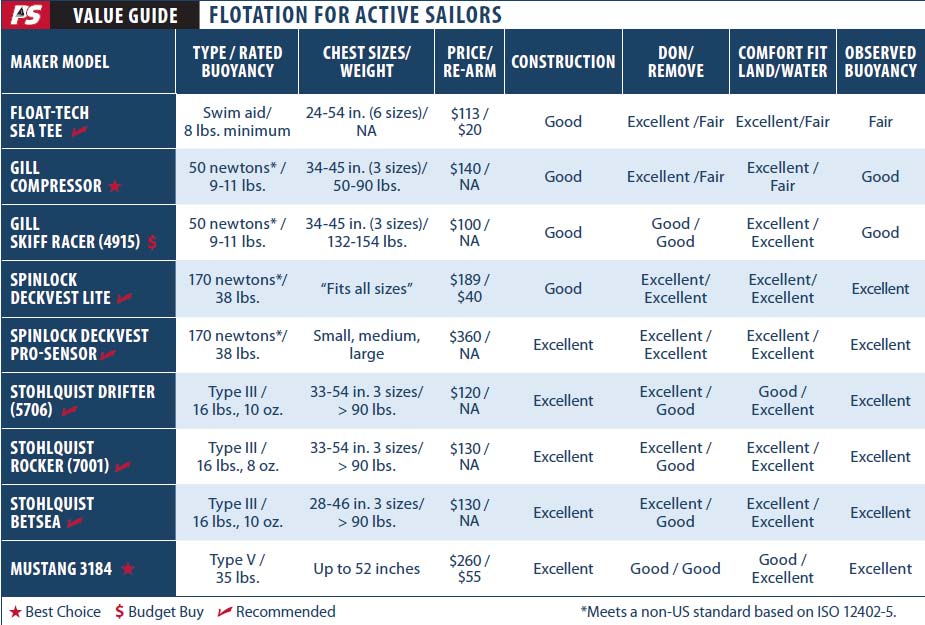
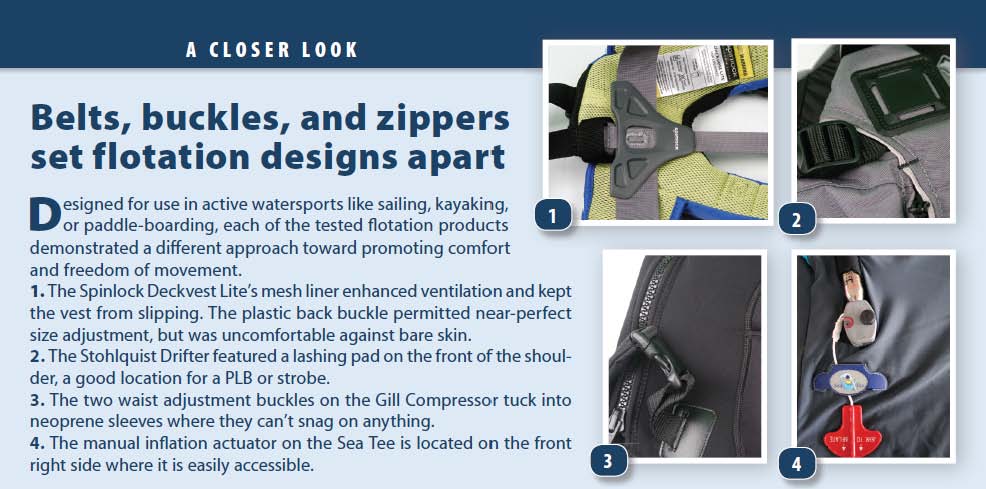








































When solo on my Cape Dory 32 I feel much more comfortable with my kayak PFD Kokatat MsFit Tour ($165) rather than an auto inflatable. The Kokatat has a pocket for a VHF, as well as two additional pockets, one which has my EPIRB. I know quite a few men who also wear this version.
Looking to replace an Extrasport women’s type III with something very similar. ALL of the women’s USCG approved life jackets we have found are “kayak” type vests, which have a bulky high rear flotation section and bulky low side and/or front flotation sections. These might be great for kayaking, but not so good for competitive sailing. We have “trust issues” with inflatables, especially after a few well-publicized incidents where they failed to inflate. Any suggestions for a USCG women’s type III?